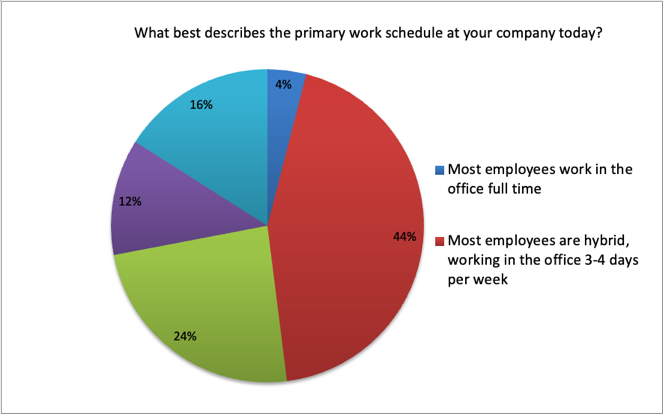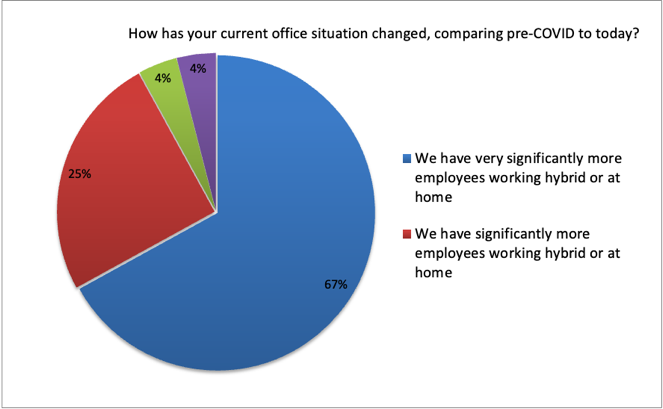Is Work-From-Home, Hybrid, or Work-From-Office the Future for Shared Services / GBS?
Introduction
For decades prior to the COVID pandemic many leading Shared Services / GBS organizations had some type of flexible work arrangement policies in place to improve morale and create trust with employees by allowing them flexibility to work around childcare and other non-work activities that are difficult to accomplish outside of work hours. When these arrangements expanded beyond flex time, employees were able to work from home for part of their work week, giving them additional flexibility to schedule their worktime and reduce time and costs for commuting to the office.
Beginning in early 2020 with the COVID pandemic, flexible work arrangements took a major leap forward for all Shared Services around the world, with a dramatic shift to support most work activities taking place remotely, and most often from an employee’s home. This was a “burning platform” situation, with no other viable options available. Now, in 2024, Shared Services leaders are wondering what approach is optimal. Fortunately for Peeriosity-100 members, it is easy to find out how their strategies for remote working compare with the strategies of other leading Share Services organizations.
Polling Results Review
The results from a recent Peeriosity poll provides insight into how companies navigating the complex issues for whether employees work from home, or work from a more traditional office environment. The first poll question asked member companies to characterize the work schedule in Shared Services/GBS today. Interestingly, only 4% indicated that most employees work in the office full time. The most popular response at 44% indicated that employees are hybrid, working in the office 3-4 days per week. The next most popular response at 24% also indicated a hybrid model was used, with employees in the office 1-2 days per week. In addition, 12% indicated that most employees work from home full time, and the remaining 16% indicated they have a fairly even split of employees working at home full time and employees working on a hybrid schedule.
So, when you step back and look at the big picture, about half of Peeriosity member companies are placing more emphasis on having employees in the office, at least more than half of the time, and for the other half of Peeriosity member companies, employees have greater freedom to work from home. Here are the details:

The second polling question looked more closely as how current requirement for employees to work from the office today compare with pre-COVID requirements. For 92% of Peeriosity member companies, there are either very significantly, or significantly more employees working hybrid or at home, with 4 percent indicating the percentages were only slightly higher, and 4 percent indicating the office situation was not much different today that it was pre-COVID.

A few of the comments from members include:
- We recommend employees work hybrid in the office 3 days a week but compared to pre-covid, the numbers in the office are low.
- Senior leadership has been very open to what employees want. We had 3 campuses and went down to 2 after we received feedback that enough people preferred to WFH. This approach has significantly helped with employee morale and retaining employees. This contrasts with other companies in the area that have kept their corporate leases and forced employees to return to the office.
- Some divisions choose the days people need to come into the office and others are a little more flexible, but 3 days is the minimum for now.
- For us the Shared Services Center requirement is 1-2 days in office. Most of the other business groups require 3 days in office.
- We expect employees to work a minimum of 3 days in office. This varies by site and country a bit. We value the interactions and engagement this promotes.
- We have a flexible approach with a mix of in office full time, hybrid, and work from home full time. The majority of employees choose to work from home full time.
Closing Summary
For Peeriosity member companies, responding to COVID-19 required quick and decisive action that pushed the boundaries for how Shared Services work activities are performed. Temporary measures soon became long term with member companies shifting to a virtual work model for almost all staff for two years. With the new multi-year reality of COVID came the realization that pushing the boundaries for where work needed to be performed was surprisingly successful, with work getting completed, plus many positive outcomes on employee morale. Today, two years after the pandemic has ended with the original threat no longer present, most companies are only shifting slightly back toward their pre-pandemic model, with the likely outcome that providing greater flexibility for employees to work from home is design change that is here to stay.
What are your companies’ requirements to work from the office for your Shared Services/GBS workforce? What has been your decision criteria, and how were decisions made for defining your after-COVID strategy for where work is performed?
Who are your peers and how are you collaborating with them?
_____________________________________________________________
“Polling” is available exclusively to Peeriosity-100 member company employees, with consultants or vendors prohibited from participating or accessing content. Members have full visibility to all respondents and their comments. Using Peeriosity-100’s integrated email system, Peer Mail, members can easily communicate at any time with others who participated in Polling.
Peeriosity members are invited to log into www.peeriosity.com to join the discussion and connect with Peers. Membership is for practitioners only, with no consultants or vendors permitted. To learn more about Peeriosity, click here

